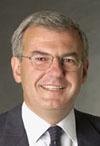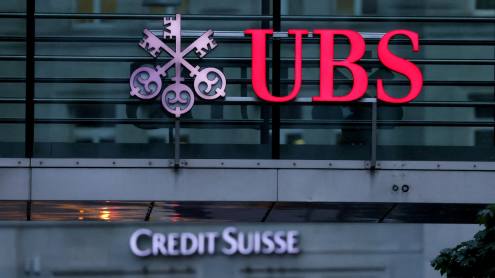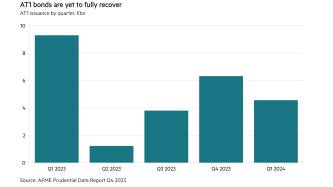What a difference a year can make. That thought may have been high in the mind of Mario Draghi, the Bank of Italy’s governor, when he addressed the bank’s annual meeting on May 31.
Exactly one year earlier, Mr Draghi had stood for the first time before the packed ranks of Italy’s financial, political and business leaders to make the governor’s annual address.
Strong words
Drafted in following the dramatic resignation in December 2005 of Antonio Fazio in the wake of the Banca Popolare di Lodi affair, Mr Draghi spoke then about “a convulsive period of scandal and speculation during which it seemed that the market, the savings of Italians and the destiny of companies in important sectors of the national economy were prey to the will, the interests and the plotting of a few individuals”.
Nobody sits at Goldman Sachs’ top table – as Mr Draghi did for four years before answering the call to return to Rome and repair the tarnished reputation of the country’s central bank – without having already digested the ideas and ideals of the liberal market economy. And towards the end of his address, he listed the various market-friendly measures that the central bank introduced during 2006 and the opening months of this year.
An evaluation of all the supervisory service’s rules has been put in hand with the aim of drastically cutting their number. The procedures for opening new branches have been simplified. And, crucially, the central bank has abolished the requirement that banks should inform it in advance of their intentions to acquire other banks. So banks’ managements and shareholders no longer need to go cap in hand to ask for permission to do deals.
Change to market
That single, simple change to allow the market to decide how the future should be for Italy’s banks helps to explain how Mr Draghi was able to begin the part of his address that deals with the banking sector as he did this year.
“One year ago, the two largest Italian banks ranked seventh and 18th in Europe by market capitalisation,” he said. Now, if a deal announced by boards of directors is approved, “Italy’s two largest banks will rank third and 11th”.
The deal to which Mr Draghi referred, announced just 11 days before the Bank of Italy’s annual meeting, is the takeover of Capitalia by UniCredit. It followed nine months after the surprise announcement of a merger between Banca Intesa and Sanpaolo IMI that enabled the new entity to open a gap with UniCredit in terms of market capitalisation and market share in Italy.
At the end of August last year, soon after the deal was revealed that created Intesa Sanpaolo, John Andrew, chairman of Eidos Partners (a boutique investment bank in Milan) who has been involved in numerous banking operations in Italy, spoke to The Banker. “What will UniCredit do next? Will it take over Capitalia?” he asked.
Everyone now knows the answer and the probability that the two banks’ shareholders will turn down what their managements have agreed is close to zero. What has happened during Mr Draghi’s brief watch so far is that the Italian banking system, until a few years ago a collection of small, medium and bigger-than-medium institutions, has brought forth two continental-scale banks.
Concerns that Italy would be left vulnerable to big foreign banks have been laid to rest. The country now has two banks large enough to be predators abroad. And as things stand, not much that is appetising seems left for foreigners to swallow in Italy.
Capitalia’s biggest shareholder is ABN AMRO, whose hopes of bringing this bank together with Antonveneta, which it won following the Banca Popolare di Lodi scandal, have now been dashed. BNP Paribas owns Banca Nazionale del Lavoro and Crédit Agricole has a network of branches that once belonged to Banca Intesa where it is a big shareholder.
These three foreigners have acquired Italian subsidiaries following Mr Draghi’s arrival at the central bank, although a fourth foreign bank, Deutsche Bank, did arrive more than 20 years ago to buy the Banca d’America e d’Italia.
“One can certainly talk about a Draghi effect,” said John Andrew, after UniCredit announced its takeover of Capitalia. “Little happened under Fazio. The change is dramatic – night and day – and it is good news for Italy,” he added.
|
| “Of course Draghi is important. He has radically changed the way things are done,” said Alessandro Profumo, UniCredit’s managing director. |
However, according to Corrado Passera, Intesa Sanpaolo’s managing director: “Draghi’s arrival helped the process of consolidation but it had been under way for some time. These two big mergers are the result of a series of operations.”
That is true, but before Mr Draghi took over at the central bank, it was this institution and Italy’s meddlesome politicians that guided consolidation in the banking industry, not the market. Mergers and takeovers were very political affairs.
Merger veteran
Mr Passera is an old hand at mergers, having been managing director of Banco Ambrosiano Veneto (itself the result of a merger between Nuovo Banco Ambrosiano and the Banca Cattolica del Veneto) when it merged with Cariplo, Italy’s biggest savings bank, in 1998.
“This was the first big merger, the first big move,” he says. He was called back in 2002 to oversee the merger, which had run into difficulty, of Banca Intesa (the result of the 1998 merger) with Banca Commerciale Italiana.
Yet despite his experience, even Mr Passera has been taken back by what has happened. “Nobody would have believed three years ago that Italy would produce two European-sized banks. The speed and extent of the change has surprised everybody,” he tells The Banker.
And his bank was the first to take advantage of Mr Draghi’s hands-off way of managing matters. Last summer’s deal created a bank with an Italian network of about 6000 branches and a market share of 18%. Moreover, the bank is strong on the ground, where it counts.
“Approximately 60% of Intesa Sanpaolo’s branches are located in the north, which generates 54% of GDP, giving the bank a gearing to the wealthiest regions,” noted Matteo Ramenghi, an analyst at UBS in Milan, soon after the merger was announced.
This was the challenge that UniCredit faced and is meeting with its takeover of Capitalia. The merged entity, on which shareholders are expected to vote at the end of July and which will become effective in October, will have about 5000 branches in Italy and a market share of 16%.
So the merger will close the gap with Intesa Sanpaolo. “It is a logical deal,” says Mr Passera.
With Capitalia’s presence strongest in the centre, where its origins were with Banco di Roma and Cassa di Risparmio di Roma (the capital’s savings bank), and the south, through Banca di Roma’s acquisition of Banco di Sicilia (which had previously taken over Sicilcassa), there will be little overlap for UniCredit’s management to tackle.
A good deal
On the minus side, the south is much poorer than the north and has more non-performing loans. Overall, however, the deal looks a good one. According to Mr Ramenghi: “The in-market nature of the merger, potential to rationalise Capitalia’s cost base, limited network overlaps and management track record in restructuring should ensure a rapid and smooth delivery of synergies.”
On UniCredit’s own forecast, around €1.2bn of synergies should be obtainable in the next three years, with more than two thirds being squeezed from cost savings. Mr Ramenghi pointed to how Capitalia’s organisation, with around one fifth of staff working in central functions, lends itself to deep cost-cutting.
Possibly, UniCredit’s managers will discover more opportunities to reduce costs when they start looking closely and getting into the details of integrating Capitalia. When Intesa Sanpaolo presented its business plan in mid-April, the bank said that projected cost synergies amounted to €1.2bn, which was €265m higher than had been forecast when the merger was announced. Some 6500 employees, mainly in back-office and information and communications technology activities, were identified as surplus to requirements.
Delivering the goods
In banking as in any business, the successful implementation of a merger depends as much on management’s qualities as anything else. And both Intesa Sanpaolo’s Mr Passera and UniCredit’s Mr Profumo have delivered the goods in the past.
On the surface, there are similarities: both spent time at McKinsey dealing with banks. They are of a similar age, Mr Passera, at 52, being two years older than his counterpart at UniCredit. And both have built major banks through series of mergers.
“They are two very capable CEOs who are similar from the outside,” remarks Mr Andrew.
However, they have very different strengths and qualities. Mr Passera is thought to be somewhat closer to Italy’s politicians than Mr Profumo. “Passera is a man for detail, for the organisation chart, a technician. Mr Profumo has a more international, strategic view,” adds Mr Andrew.
Another Milan insider has a different take on how the two manage their banks, believing that while UniCredit has management strength in depth, the same is not true of Intesa Sanpaolo.
“Everything would run smoothly if Profumo were to take a two-month holiday, but the bank would grind to a halt if Passera took two weeks off,” he says.
Mr Andrew’s reflection on Mr Profumo’s internationalising skills is rather surprising because it is Mr Passera’s CV that contains a rich international vein. After graduating from Milan’s prestigious Bocconi University, he obtained an MBA at the Wharton School in Philadelphia and after five years with McKinsey, where he had assignments in banking and insurance, he worked for 11 years in Carlo De Benedetti’s CIR group which, as well as Olivetti, had numerous important European subsidiaries.
Mr Passera’s capacity for mastering detail was certainly a key to his success in turning round the Italian Post Office, which he headed between 1998 and 2002. Yet banking, where he is in the top flight, is obviously in his blood.
“I have been in banking three times. First, there were those years with McKinsey, then the period at Banco Ambrosiano Veneto when we merged with Cariplo and now at Intesa Sanpaolo. One cannot plan life, but it was easy to say yes when I was given the chance to return to Intesa,” he muses.
Mr Profumo’s CV is a less exciting read. He, too, is a Bocconi graduate but he earned his degree while working for a medium-sized provincial bank where he was employed from 1977 to 1987. And there was no US business school for him, just two years with McKinsey and a further two with consultancy Bain Cuneo. “McKinsey was my business school. It taught me how to judge important people,” he has said.
Both before his consultancy experience, with Banco Lariano, and after, first with RAS for three years until 1994 and since then with UniCredit and its predecessor, Credito Italiano, Mr Profumo has only been a banker. But, with surprising leaps abroad, to buy (among other things) Poland’s Bank Pekao in 1999, America’s Pioneer Investments in 2000 and Germany’s HVB two years ago, he has shown himself to be a very good banker.
European strength
Both Intesa Sanpaolo and UniCredit are strong in central and eastern Europe. Intesa Sanpaolo’s list of subsidaries reads like a travel guide, rather biased towards the Balkans with subsidiaries in Albania, Bosnia, Croatia, Romania and Serbia.
Croatia and Romania appear in UniCredit’s list, along with Bulgaria, Slovakia and the Czech Republic, and Mr Profumo’s bank is number one in Austria. Both he and Mr Passera put growth in eastern Europe – Mr Profumo more towards the centre, Intesa Sanpaolo’s CEO more towards the south – at the top of their priorities even while getting their big domestic mergers tidied away.
“Growth in central and eastern Europe will proceed,” says Mr Profumo.
Mr Passera, meanwhile, told The Banker: “We will continue to extend into eastern and southern Europe. If we can find good banks at reasonable prices, we will buy.”
It sounds as if Italy’s two top bankers will continue to be on the move, reinforcing their banks abroad after making them almost invincible at home.












